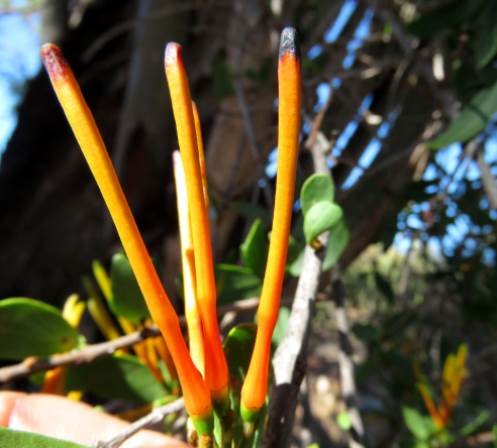Moquiniella rubra orange tubes

Author: Ivan Lätti
Photographer: Louis Jordaan
The flowers in this Moquiniella rubra umbel are still closed but already black or blackening at their tips, prepared for anthesis. Pollinators are usually sprayed with pollen during the explosive parting of petals at opening. This is when the anthers usually break off, an even which cannot be too far into the future here. The recipient of the spraying is often a sunbird, its beak equipped for accessing tubular flowers, although events unfold surprisingly here.
Because the presence of a pollinator isn’t guaranteed at the critical moment, the plant is many-flowered, like people who buy many lottery tickets. If these plants hadn’t been “sufficiently flowered” over the years, the photo would neither have been taken, nor the plants seen anymore.
Such is the simultaneously robust and delicate nature of survival chances of so many living things on earth: strong as long as the critical variable values remain in the functional intervals for supporting life. And every species has its own set of requirements.
Veld life may appear a straight forward affair, but even slight changes in ecological patterns are accompanied by danger for some. Only a small percentage of all species that ever lived is still extant today. They all struggle, the outcomes never guaranteed, although short term vigour or good times creates longevity and even immortality illusions in some.
The M. rubra flower colour and tube shape change visibly about one quarter from these corolla bases. This may indicate the points where the filament bases of the stamens are attached to the inside walls of the tubes (Vlok and Schutte-Vlok, 2015; Coates Palgrave, 2002; Leistner, (Ed.), 2000; iNaturalist).

